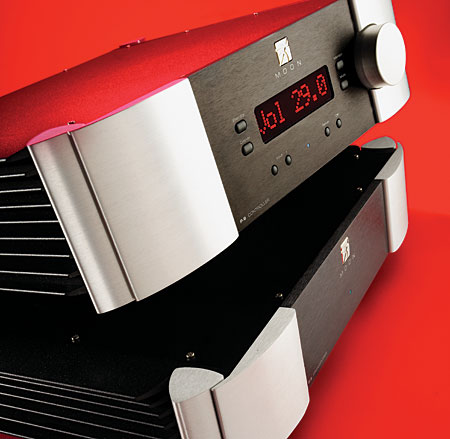| Columns Retired Columns & Blogs |
Simaudio Moon Evolution P-8 preamplifier
The P-8 ($11,000) is the second of Simaudio's Moon Evolution series that has passed through my system, following on the heels of the Moon Evolution W-8 power amplifier, which I reviewed in March 2006. Fortunately, the P-8's arrival preceded the W-8's departure, so I was able to use them together as well as with other components.

The Evolution bodywork, first seen in the W-8, is a major aesthetic step up for Simaudio, and it's even more appealing in the P-8, which adds a remarkably legible and useful display, a large volume-control knob, and other effective controls. As with the W-8, Sim provides sharp spikes for each chassis, but thankfully, these are user-installable.
In appearance and mass, the two-chassis P-8 is as imposing as the W-8. It comprises the Controller chassis, which contains the display, all the controls (natch), and a power supply capable of driving the Preamplifier chassis and an additional device, such as a phono stage or DAC. All AC is contained within the Controller chassis, which connects to the Preamplifier chassis by means of two four-pin XLR cables, each providing the DC supplies for a single channel. The Controller directs the Preamplifier functions via a cable using an 8-pin Ethercon connector within the XLR shells. All audio signals are kept within the Preamplifier chassis. Despite this separation of powers, the two units operate as one.
Inside the Controller are two entirely dual-mono power supplies, fed from three toroidal transformers. Sim is obsessive about supply filtering, to the point of adding an inductive filter at each and every chip in the Preamplifier's audio path: a total of 40 such stages in all. This is in addition to using four-layer PCB construction for better grounding and shorter signal paths.
The extremely silky volume control operates via a system called M-Ray, which consists of a pair of R-2R resistor ladders similar to those in DAC chips, but with 0.1% tolerances and 530 individual steps of 1dB (0–30dB) and 0.1dB (30–80dB). I generally used levels in the 40–65dB range and benefited from the smaller increment. In addition, the volume control array can be programmed for each input for gain offset (to balance their volume levels) and maximum volume (to prevent excessive output). Also, any input can be set to a fixed 0dB gain with volume control inoperable, so that it can operate as a home-theater bypass. Adjustment of the left/right balance is available only from the remote control, which continues Sim's tradition of hefty, club-like remotes. It lies snugly in the hand and manages all the basic operations of the P-8, as well as other associated equipment. Just don't drop it on your toe.
The main power switch is on the Controller's rear panel, along with an IEC power connector and AC fuse post. Also on the rear panel are the XLR DC power connections, modular communications connectors, dual 12V trigger outputs, RS-232 connector, IR control input, and in/out receptacles for SimLink, a proprietary communications/control protocol for other Moon Evolution devices, such as the W-8 and the Andromeda CD player. On the Preamplifier's rear, the four RCA inputs and the three XLR inputs are symmetrically placed on the extreme left and right, respectively, with the output and tape-loop jacks clustered in the center around the DC supply and communications connectors.
The front of the Preamplifier, which contains all the audio circuitry, bears nothing more than a centrally located LED to indicate that it is powered and operational. The user interface is the front of the Controller and the remote control. The large, smooth-turning volume knob and the large digital display dominate the controller's face. The display—large, bright (or not—it's adjustable), and configurable—joins those of the Camelot Uther and the Meridian Reference 861 in the pantheon of the most informative and legible displays I have used.
On each side of the display are two pairs of buttons, and under it are two more pairs. Top left is the Standby button, which toggles the P-8 between its fully operational and standby modes. Under that is the Display button, which selects among the display's three levels of brightness, as well as whether or not the display remains on, or illuminates only during and shortly after any control operation. I left it on. Top right is the Monitor button, which routes the currently selected input to the tape output, and lets you monitor whatever's connected to the tape input. Under this is the Mute button.
On the panel's lower left, under the display, are two buttons with which you step up or down to select from the list of inputs. To the right of these are the programming buttons, labeled Setup and OK. Using only these buttons and the owner's manual's handy Quick Reference sheet, you can, for each input, select a meaningful display label, set maximum volume and volume offset, enable that input as a bypass channel, or disable the input entirely. Setup also lets you associate either of the 12V triggers with any input selection. Overall, I found the P-8's functions and programming almost intuitive, and all its operations trouble-free and nearly silent. The exceptions were the barely audible relays going about their business, but this happened only during control operations.
No missing link
Setup was pretty simple. Most of the inputs I used were single-ended. I did, however, connect the Bel Canto PL-1A universal player via both XLR and RCA, and the outputs were via XLR to the W-8, the Classé CA-3200, or various Bel Canto power amps. I programmed the display so that, instead of Bal1, SE1, SE2, and SE3, it read Bel Canto, Sony, FM, and Phono, with the other inputs disabled. It made for a real easy transition for me—I often forget what's connected to what, especially when a new component is inserted in the system. My wife liked it, too.
- Log in or register to post comments




































